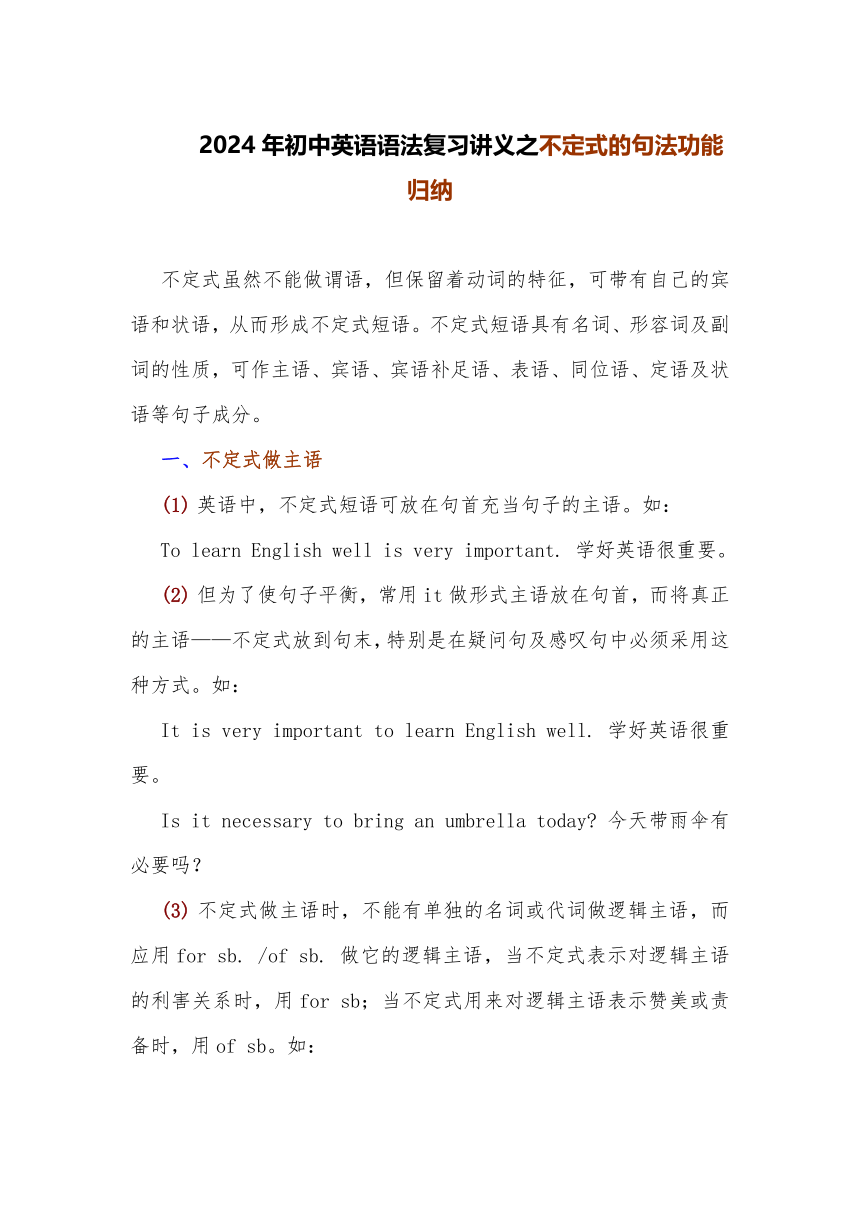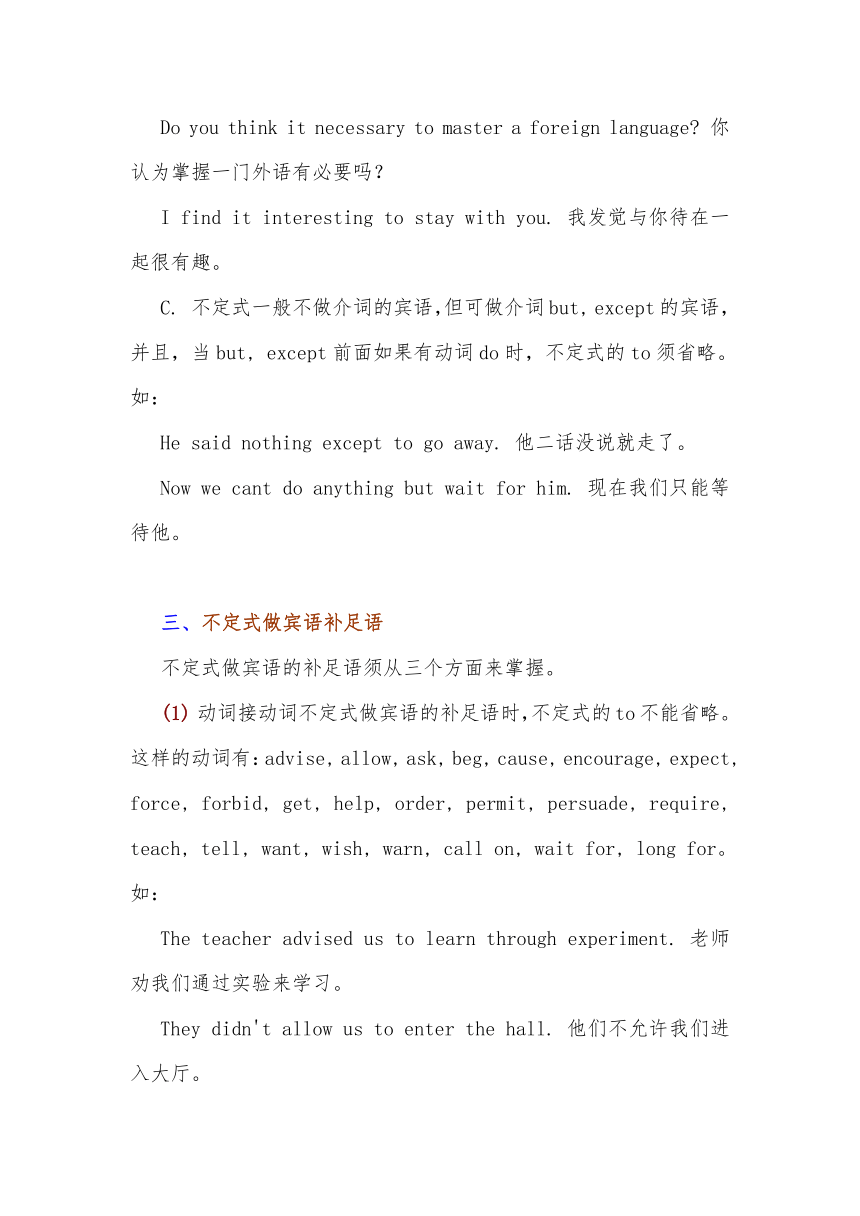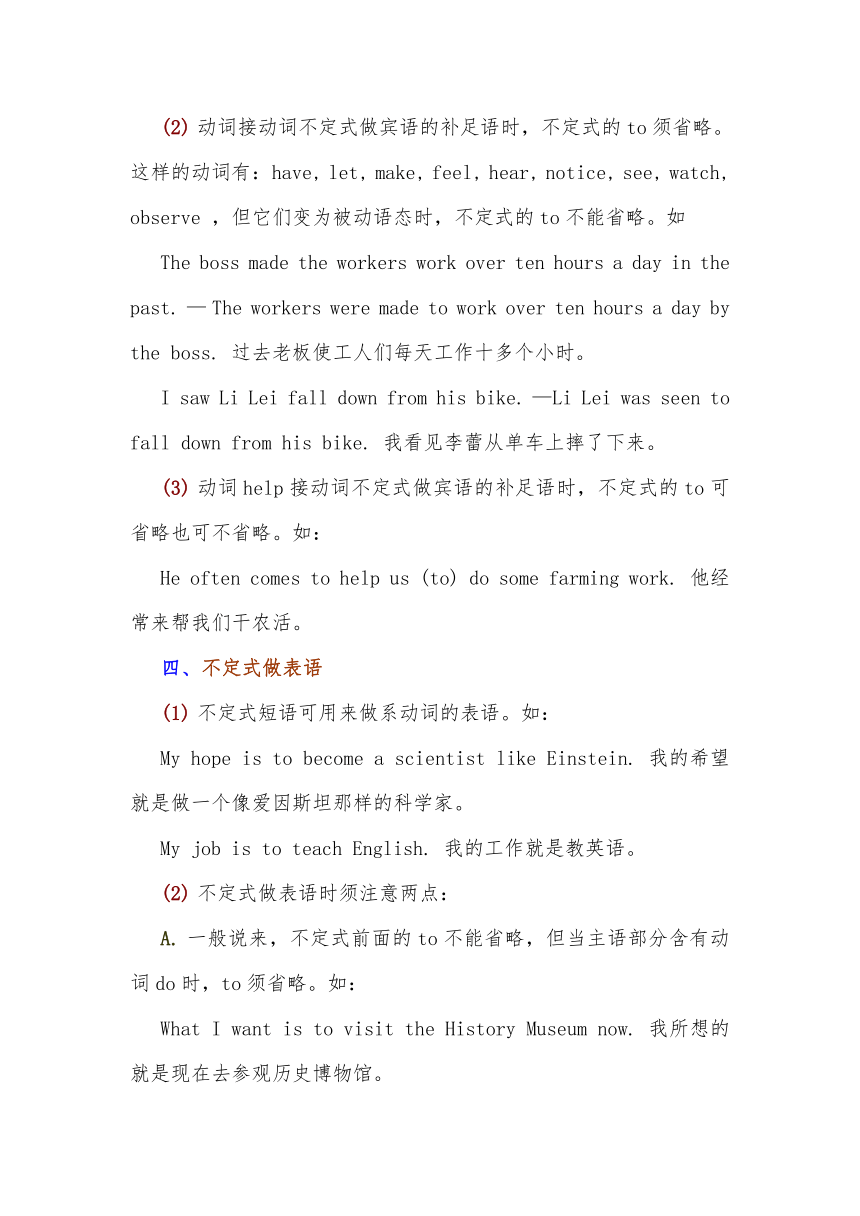2024年初中英语语法复习讲义之不定式的句法功能归纳
文档属性
| 名称 | 2024年初中英语语法复习讲义之不定式的句法功能归纳 |  | |
| 格式 | docx | ||
| 文件大小 | 22.4KB | ||
| 资源类型 | 教案 | ||
| 版本资源 | 通用版 | ||
| 科目 | 英语 | ||
| 更新时间 | 2023-09-17 07:38:36 | ||
图片预览




文档简介
2024年初中英语语法复习讲义之不定式的句法功能归纳
不定式虽然不能做谓语,但保留着动词的特征,可带有自己的宾语和状语,从而形成不定式短语。不定式短语具有名词、形容词及副词的性质,可作主语、宾语、宾语补足语、表语、同位语、定语及状语等句子成分。
一、不定式做主语
(1) 英语中,不定式短语可放在句首充当句子的主语。如:
To learn English well is very important. 学好英语很重要。
(2) 但为了使句子平衡,常用it做形式主语放在句首,而将真正的主语——不定式放到句末,特别是在疑问句及感叹句中必须采用这种方式。如:
It is very important to learn English well. 学好英语很重要。
Is it necessary to bring an umbrella today 今天带雨伞有必要吗?
(3) 不定式做主语时,不能有单独的名词或代词做逻辑主语,而应用for sb. /of sb. 做它的逻辑主语,当不定式表示对逻辑主语的利害关系时,用for sb;当不定式用来对逻辑主语表示赞美或责备时,用of sb。如:
It is not good for your eye to read in the sun. 在阳光下看对你的眼睛不好。
It is very kind of you to help us. 你来帮助我们,真是太好了。
二、不定式做宾语
(1) 在英语中,不定式可用来做宾语。如:
He agrees to go with us. 他同意跟我们一起去。
I want to buy a Chinese-English dictionary. 我想买一本汉英词典。
(2) 不定式做宾语时须注意:
A. 不定式并不是可做任何及物动词的宾语。能接不定式做宾语的动词有:afford, agree, arrange, ask, attempt, begin, care, choose, continue, dare, decide, desire, demand, determine, elect, expect, fail, hate, hesitate, hope, intend, know, learn, like, long, love, manage, mean, need, offer, plan, prepare, promise, pretend, prefer, refuse, require, start, try, wait, want, wish, wonder. 如:
I cant afford to buy such an expensive computer. 我买不起这么昂贵的电脑。
He decided to work in that factory. 他决定去那家工厂工作。
B. 做宾语的不定式如果带有自己的补足语,则须用it做形式宾语,而将真正的宾语置于补足语之后。如:
Do you think it necessary to master a foreign language 你认为掌握一门外语有必要吗?
I find it interesting to stay with you. 我发觉与你待在一起很有趣。
C. 不定式一般不做介词的宾语,但可做介词but, except的宾语,并且,当but, except前面如果有动词do时,不定式的to须省略。如:
He said nothing except to go away. 他二话没说就走了。
Now we cant do anything but wait for him. 现在我们只能等待他。
三、不定式做宾语补足语
不定式做宾语的补足语须从三个方面来掌握。
(1) 动词接动词不定式做宾语的补足语时,不定式的to不能省略。这样的动词有:advise, allow, ask, beg, cause, encourage, expect, force, forbid, get, help, order, permit, persuade, require, teach, tell, want, wish, warn, call on, wait for, long for。如:
The teacher advised us to learn through experiment. 老师劝我们通过实验来学习。
They didn't allow us to enter the hall. 他们不允许我们进入大厅。
(2) 动词接动词不定式做宾语的补足语时,不定式的to须省略。这样的动词有:have, let, make, feel, hear, notice, see, watch, observe ,但它们变为被动语态时,不定式的to不能省略。如
The boss made the workers work over ten hours a day in the past. — The workers were made to work over ten hours a day by the boss. 过去老板使工人们每天工作十多个小时。
I saw Li Lei fall down from his bike. —Li Lei was seen to fall down from his bike. 我看见李蕾从单车上摔了下来。
(3) 动词help接动词不定式做宾语的补足语时,不定式的to可省略也可不省略。如:
He often comes to help us (to) do some farming work. 他经常来帮我们干农活。
四、不定式做表语
(1) 不定式短语可用来做系动词的表语。如:
My hope is to become a scientist like Einstein. 我的希望就是做一个像爱因斯坦那样的科学家。
My job is to teach English. 我的工作就是教英语。
(2) 不定式做表语时须注意两点:
A. 一般说来,不定式前面的to不能省略,但当主语部分含有动词do时,to须省略。如:
What I want is to visit the History Museum now. 我所想的就是现在去参观历史博物馆。
What he wants to do is go swimming in that river. 他想做的事就是去河里游泳。
B. 不定式的逻辑主语是句子的主语时,表示主语的责任、义务或将来的行为;当不定式的逻辑主语不是句子的主语时,不定式是表语,表示主语的内容或性质。如:
We are to keep the order in the street. 我们将去街上维持秩序。(将来时)
Our job is to keep the order in the street. 我们的工作是维持街上的秩序。(系表结构)
五、不定式做定语
(1) 不定式做定语时,一般放在所修饰的名词、代词之后,表示即将发生的动作。如:
We have much work to do. 我们有很多事情要做。
I have a letter to answer. 我有一封信要回复。
(2) 不定式做定语时,中心词与不定式的关系:
A. 主谓关系,即:中心词是不定式的逻辑主语。如:
Li Lei was the first student to come into the classroom this morning. 今天早晨李蕾是第一个进教室的学生。
Liu Ying was the very girl to meet you. 刘英正是来接你的那个女孩子。
B. 动宾关系,即:中心词是不定式的逻辑宾语。如:
Do you have anything to do now 你现在有事情要做吗?
I have some clothes to wash. 我有些衣服要洗。
当不定式与所修饰的中心词有动宾关系时,不定式中的动词须为及物动词,若是不及物动词,不定式后须加上适当的介词。如:
Go ahead, please. I have a friend to wait for here. 请先走吧,我还有个朋友要在这儿等。
C. 说明关系,即:不定式是中心词的内容。如:
I had a dream to fly in the sky like a bird. 我做了一个像鸟儿在天上飞的梦
I have a wish to go to college. 我有一个上大学的愿望。
六、不定式做状语
不定式做状语,可表示动作的目的、结果、原因、条件和方式。
A. 表目的
表目的时,不定式可放在句子的前面也可放在句子的末尾。但在句子前面时,不定式常与句子用逗号隔开;而在句子末尾时一般不用逗号隔开。如:
To get there on time, we set out at five in the morning. 为了按时到达那儿,我们早晨五点就出发了。
He goes there to enjoy the fresh air. 他去那儿享受那儿的新鲜空气。
比较:to do, in order to do, so as to do都可表示目的,但to do, in order to do的位置既可在句首,又可在句末;而so as to do只能在句末。
In order to build a house, he bought some wood and steel yesterday. —He bought some wood and steel yesterday in order to build a house. / He bought some wood and steel yesterday so as to build a house. 为了建房,昨天他买来了木料和钢材。
B. 表结果
不定式在下列结构中表示谓语动作的结果,不定式的位置一般在句子末尾。
(1) 表示终结性的动词find, see, hear, learn, discover的不定式,常表示出乎意料的结果,并且,不定式前常有never, only等副词修饰。如:
I hurried to the railway station yesterday, (only) to find that the train had left. 昨天我急急忙忙赶到火车站时,发现火车已经开走了。
I went to the classroom, to discover it empty. 我走到教室,结果发现教室是空的。
(2) 在 “so + adj. / adv. + as + to do”中。如:
The scenery is so beautiful as to attract many people here every year. 景色非常美,每年都要吸引很多人来这里。
(3) 在 “adj. / adv. + enough + to do”中。如:
He ran fast enough to catch up with Li Lei. 他跑得很快,结果赶上了李蕾。
(4) 在 “so + adj. / adv. +a(n) + n. + as + to do”中。如:
This is so interesting a story as to interest children. 这是个很有趣的故事,使孩子们非常感兴趣。
(5) 在 “such + adj. / adv. + n. + as + to do”中。如:
She is such a good girl to help you make great progress. 她是个非常好的姑娘,帮助你取得了很大的进步。
(6) 在 “too + adj. / adv. + to do”中。如:
They went too slowly to catch the early bus. 他们走得太慢了,结果没能赶上早班车。
C. 表原因
不定式表示原因时,一般放在句子的末尾,说明主语某种心情、情感(glad, pleased, sad, worried, sorrow, excited) 所产生的原因。如:
Im very glad to hear that Li Lei has been elected secretary of the Party. 听说李蕾被选为了党的书记,我很高兴。
D. 表条件
不定式表示条件时,一般放在句首。如:
To be heated, liquid will change into gas. 如果受热,液体就会变成气体。
E. 表方式
不定式可接在as if / as though之后表示方式时,如:
He moved his mouth as if to say something. 他的嘴唇动了动,好像要说什么事似的。
七、不定式做同位语
不定式可用作同位语,说明某些名词或代词task, idea, thought的内容。不定式做同位语时,在名词或代词与不定式之间常用逗号隔开。如:
Suddenly I have got the idea, to hunt rabbits in the woods. 突然,我有了这个想法,去林子里去猎取野兔子。
八、不定式做独立成分
To tell you the truth, I don’t like it. 告诉你实话,我不喜欢它。
不定式虽然不能做谓语,但保留着动词的特征,可带有自己的宾语和状语,从而形成不定式短语。不定式短语具有名词、形容词及副词的性质,可作主语、宾语、宾语补足语、表语、同位语、定语及状语等句子成分。
一、不定式做主语
(1) 英语中,不定式短语可放在句首充当句子的主语。如:
To learn English well is very important. 学好英语很重要。
(2) 但为了使句子平衡,常用it做形式主语放在句首,而将真正的主语——不定式放到句末,特别是在疑问句及感叹句中必须采用这种方式。如:
It is very important to learn English well. 学好英语很重要。
Is it necessary to bring an umbrella today 今天带雨伞有必要吗?
(3) 不定式做主语时,不能有单独的名词或代词做逻辑主语,而应用for sb. /of sb. 做它的逻辑主语,当不定式表示对逻辑主语的利害关系时,用for sb;当不定式用来对逻辑主语表示赞美或责备时,用of sb。如:
It is not good for your eye to read in the sun. 在阳光下看对你的眼睛不好。
It is very kind of you to help us. 你来帮助我们,真是太好了。
二、不定式做宾语
(1) 在英语中,不定式可用来做宾语。如:
He agrees to go with us. 他同意跟我们一起去。
I want to buy a Chinese-English dictionary. 我想买一本汉英词典。
(2) 不定式做宾语时须注意:
A. 不定式并不是可做任何及物动词的宾语。能接不定式做宾语的动词有:afford, agree, arrange, ask, attempt, begin, care, choose, continue, dare, decide, desire, demand, determine, elect, expect, fail, hate, hesitate, hope, intend, know, learn, like, long, love, manage, mean, need, offer, plan, prepare, promise, pretend, prefer, refuse, require, start, try, wait, want, wish, wonder. 如:
I cant afford to buy such an expensive computer. 我买不起这么昂贵的电脑。
He decided to work in that factory. 他决定去那家工厂工作。
B. 做宾语的不定式如果带有自己的补足语,则须用it做形式宾语,而将真正的宾语置于补足语之后。如:
Do you think it necessary to master a foreign language 你认为掌握一门外语有必要吗?
I find it interesting to stay with you. 我发觉与你待在一起很有趣。
C. 不定式一般不做介词的宾语,但可做介词but, except的宾语,并且,当but, except前面如果有动词do时,不定式的to须省略。如:
He said nothing except to go away. 他二话没说就走了。
Now we cant do anything but wait for him. 现在我们只能等待他。
三、不定式做宾语补足语
不定式做宾语的补足语须从三个方面来掌握。
(1) 动词接动词不定式做宾语的补足语时,不定式的to不能省略。这样的动词有:advise, allow, ask, beg, cause, encourage, expect, force, forbid, get, help, order, permit, persuade, require, teach, tell, want, wish, warn, call on, wait for, long for。如:
The teacher advised us to learn through experiment. 老师劝我们通过实验来学习。
They didn't allow us to enter the hall. 他们不允许我们进入大厅。
(2) 动词接动词不定式做宾语的补足语时,不定式的to须省略。这样的动词有:have, let, make, feel, hear, notice, see, watch, observe ,但它们变为被动语态时,不定式的to不能省略。如
The boss made the workers work over ten hours a day in the past. — The workers were made to work over ten hours a day by the boss. 过去老板使工人们每天工作十多个小时。
I saw Li Lei fall down from his bike. —Li Lei was seen to fall down from his bike. 我看见李蕾从单车上摔了下来。
(3) 动词help接动词不定式做宾语的补足语时,不定式的to可省略也可不省略。如:
He often comes to help us (to) do some farming work. 他经常来帮我们干农活。
四、不定式做表语
(1) 不定式短语可用来做系动词的表语。如:
My hope is to become a scientist like Einstein. 我的希望就是做一个像爱因斯坦那样的科学家。
My job is to teach English. 我的工作就是教英语。
(2) 不定式做表语时须注意两点:
A. 一般说来,不定式前面的to不能省略,但当主语部分含有动词do时,to须省略。如:
What I want is to visit the History Museum now. 我所想的就是现在去参观历史博物馆。
What he wants to do is go swimming in that river. 他想做的事就是去河里游泳。
B. 不定式的逻辑主语是句子的主语时,表示主语的责任、义务或将来的行为;当不定式的逻辑主语不是句子的主语时,不定式是表语,表示主语的内容或性质。如:
We are to keep the order in the street. 我们将去街上维持秩序。(将来时)
Our job is to keep the order in the street. 我们的工作是维持街上的秩序。(系表结构)
五、不定式做定语
(1) 不定式做定语时,一般放在所修饰的名词、代词之后,表示即将发生的动作。如:
We have much work to do. 我们有很多事情要做。
I have a letter to answer. 我有一封信要回复。
(2) 不定式做定语时,中心词与不定式的关系:
A. 主谓关系,即:中心词是不定式的逻辑主语。如:
Li Lei was the first student to come into the classroom this morning. 今天早晨李蕾是第一个进教室的学生。
Liu Ying was the very girl to meet you. 刘英正是来接你的那个女孩子。
B. 动宾关系,即:中心词是不定式的逻辑宾语。如:
Do you have anything to do now 你现在有事情要做吗?
I have some clothes to wash. 我有些衣服要洗。
当不定式与所修饰的中心词有动宾关系时,不定式中的动词须为及物动词,若是不及物动词,不定式后须加上适当的介词。如:
Go ahead, please. I have a friend to wait for here. 请先走吧,我还有个朋友要在这儿等。
C. 说明关系,即:不定式是中心词的内容。如:
I had a dream to fly in the sky like a bird. 我做了一个像鸟儿在天上飞的梦
I have a wish to go to college. 我有一个上大学的愿望。
六、不定式做状语
不定式做状语,可表示动作的目的、结果、原因、条件和方式。
A. 表目的
表目的时,不定式可放在句子的前面也可放在句子的末尾。但在句子前面时,不定式常与句子用逗号隔开;而在句子末尾时一般不用逗号隔开。如:
To get there on time, we set out at five in the morning. 为了按时到达那儿,我们早晨五点就出发了。
He goes there to enjoy the fresh air. 他去那儿享受那儿的新鲜空气。
比较:to do, in order to do, so as to do都可表示目的,但to do, in order to do的位置既可在句首,又可在句末;而so as to do只能在句末。
In order to build a house, he bought some wood and steel yesterday. —He bought some wood and steel yesterday in order to build a house. / He bought some wood and steel yesterday so as to build a house. 为了建房,昨天他买来了木料和钢材。
B. 表结果
不定式在下列结构中表示谓语动作的结果,不定式的位置一般在句子末尾。
(1) 表示终结性的动词find, see, hear, learn, discover的不定式,常表示出乎意料的结果,并且,不定式前常有never, only等副词修饰。如:
I hurried to the railway station yesterday, (only) to find that the train had left. 昨天我急急忙忙赶到火车站时,发现火车已经开走了。
I went to the classroom, to discover it empty. 我走到教室,结果发现教室是空的。
(2) 在 “so + adj. / adv. + as + to do”中。如:
The scenery is so beautiful as to attract many people here every year. 景色非常美,每年都要吸引很多人来这里。
(3) 在 “adj. / adv. + enough + to do”中。如:
He ran fast enough to catch up with Li Lei. 他跑得很快,结果赶上了李蕾。
(4) 在 “so + adj. / adv. +a(n) + n. + as + to do”中。如:
This is so interesting a story as to interest children. 这是个很有趣的故事,使孩子们非常感兴趣。
(5) 在 “such + adj. / adv. + n. + as + to do”中。如:
She is such a good girl to help you make great progress. 她是个非常好的姑娘,帮助你取得了很大的进步。
(6) 在 “too + adj. / adv. + to do”中。如:
They went too slowly to catch the early bus. 他们走得太慢了,结果没能赶上早班车。
C. 表原因
不定式表示原因时,一般放在句子的末尾,说明主语某种心情、情感(glad, pleased, sad, worried, sorrow, excited) 所产生的原因。如:
Im very glad to hear that Li Lei has been elected secretary of the Party. 听说李蕾被选为了党的书记,我很高兴。
D. 表条件
不定式表示条件时,一般放在句首。如:
To be heated, liquid will change into gas. 如果受热,液体就会变成气体。
E. 表方式
不定式可接在as if / as though之后表示方式时,如:
He moved his mouth as if to say something. 他的嘴唇动了动,好像要说什么事似的。
七、不定式做同位语
不定式可用作同位语,说明某些名词或代词task, idea, thought的内容。不定式做同位语时,在名词或代词与不定式之间常用逗号隔开。如:
Suddenly I have got the idea, to hunt rabbits in the woods. 突然,我有了这个想法,去林子里去猎取野兔子。
八、不定式做独立成分
To tell you the truth, I don’t like it. 告诉你实话,我不喜欢它。
同课章节目录
